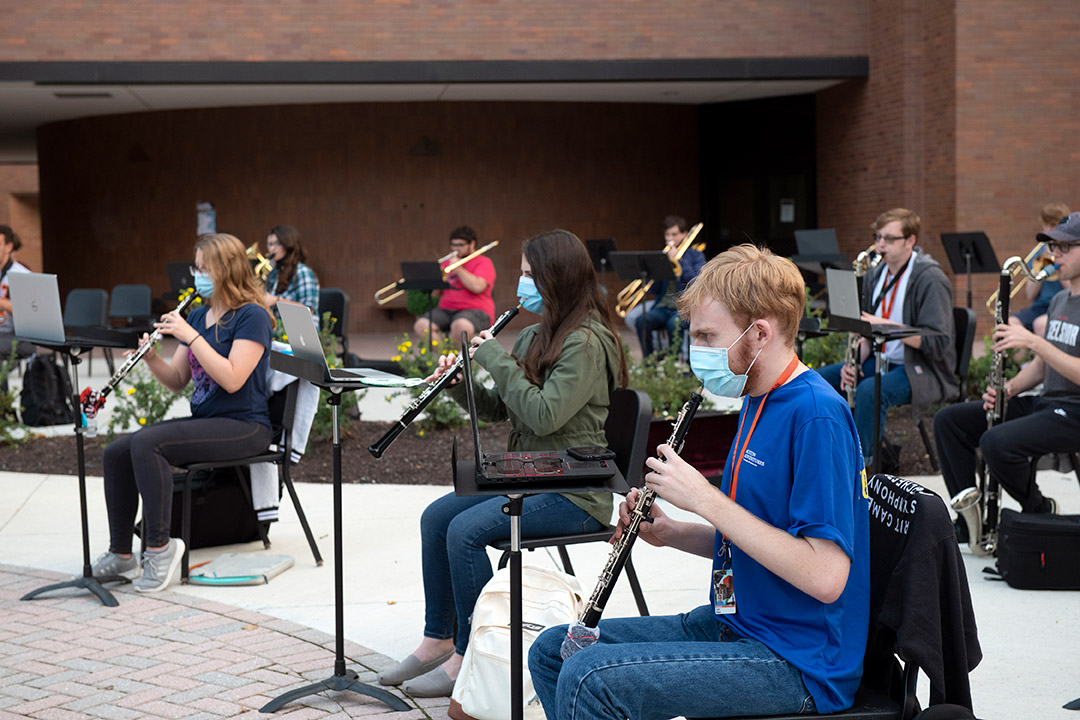Performing Arts Scholars Program flourishes
A. Sue Weisler
Members of the RIT Concert Band took advantage of good weather in September and held practice outdoors near the College of Liberal Arts.
Now in its second year, the Performing Arts Scholars Program at RIT has more than doubled in participants, with 368 first-year students involved in classical or jazz instrumental music, voice, musical theater, acting, technical theater, dance, or video game composition.
That’s up from 126 first-year students last year who received partial scholarships, renewable for up to five years as long as the student is involved in performing arts.
RIT is striving to develop the leading performing arts program in the nation for non-majors.
David Hult, director of the Performing Arts Scholars Program, said that number grew so much, in part, because “word of the program is quickly spreading. Our performing arts program has quickly captured the attention of students around the world who are looking at colleges.”
Elizabeth Lamark
Daniel Zeznick, a first-year student and recipient of a performing arts scholarship, auditions for the RIT Jazz Ensemble during the first week of classes outside the Gene Polisseni Center. Performing arts are continuing at RIT this semester despite some limitations due to COVID-19 precautions.
One recipient, Daniel Zeznick, a first-year engineering exploration student from the Rochester suburb of Pittsford, said the scholarship was one reason he chose RIT.
“Of all the schools I applied to, none of them offered a performing arts scholarship,” he said. “It definitely enticed me that I could experience performing arts on campus.”
Zeznick plays alto saxophone in the RIT Jazz Ensemble, takes private lessons via Zoom, and has attended an outdoor meeting of the RIT Jam Club.
Another scholarship recipient, Abby Wojehowski, a first-year biomedical engineering student from Marlboro, N.Y., is a member of RIT’s Vis Viva Dance Company and performing team, which she says has given her the opportunity to branch out and meet people from outside her major.
“I have been dancing for 15 years and this scholarship allows me to do that with the addition of a coach to help guide me, and so many chances to further my dance education,” Wojehowski said. “It allows me to continue doing something I love, while simultaneously helping me pursue my goals academically.”
And Jordan Reeves, a new media interactive development major from Saline, Mich., is taking vocal lessons and plans to audition for a cappella groups.
“I didn’t actually know about the scholarship before deciding on RIT, but when I found out about it, I was delighted,” she said. “I did know RIT had a good music program and that is part of why I chose RIT.”
Jonathan Kruger, chair of RIT’s Department of Performing Arts, said RIT President David Munson and the administration proposed the idea for the scholarships to help find more engaged and creative students. Only 10 percent of RIT students were involved in performing arts, compared to many more in some other technological universities.
Hult calls the scholarship recipients “talented, bright, highly motivated, self-starters, high achievers, disciplined, and academically gifted. They are truly an impressive group of students and want to leave space in their lives for the performing arts.”
Today, well over 1,000 students, from all nine colleges, participate in RIT-recognized performance groups and activities.
More venues are in the works for students to practice and perform, including a black box theater, music rehearsal space, and a dance studio in the Innovative Maker and Learning Complex.
Plans are in the design phase for a new performing arts center on campus that will feature two theaters.











